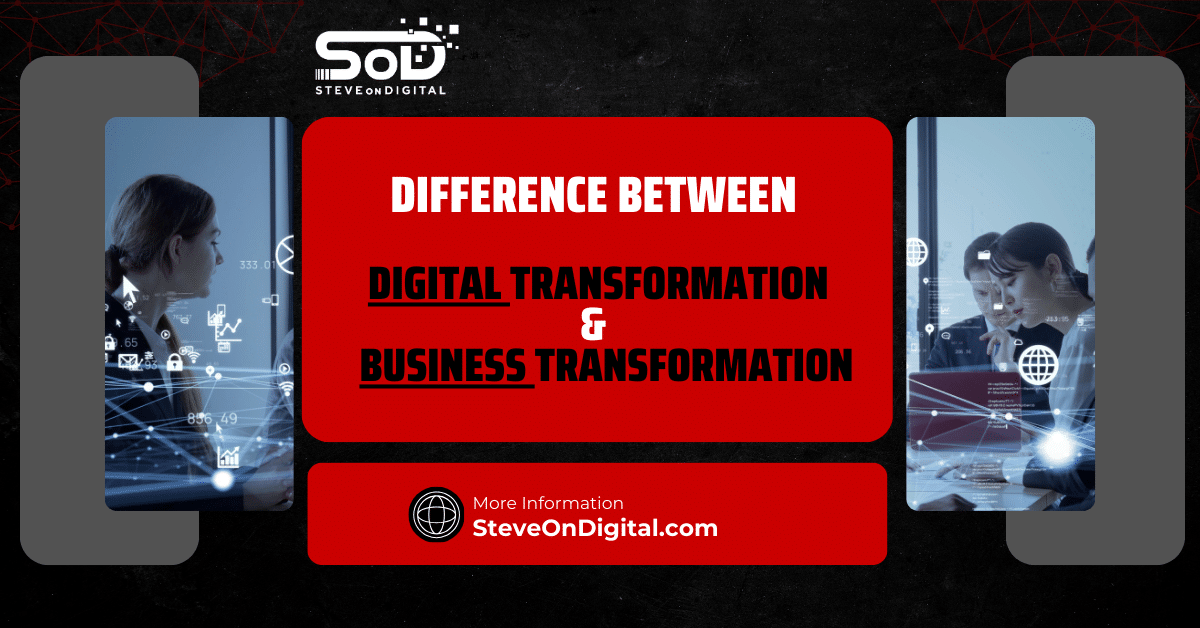In the realm of business, innovation stands as the cornerstone of growth, adaptation, and long-term success.
As Steve Johnston, a digital transformation specialist with a rich background in electrical engineering, an MBA, and a master’s in Project Management, I’ve observed firsthand the transformative power of innovation in small and medium-sized enterprises (SMEs).
Through this blog post, I aim to demystify the concepts of open and closed innovation, crucial elements within the broader spectrum of innovation management.
In today’s rapidly evolving economy, mastering the intricacies of innovation management is not just an advantage; it’s a necessity.
Open and closed innovation are two models that dictate how a business approaches the development of new products, services, and technologies.
While both have their place in the annals of business strategy, understanding their unique characteristics and applications can significantly impact an organization’s ability to innovate effectively.
Part 1: Understanding Open And Closed Innovation
Definitions And Core Concepts
Open innovation is a model that emphasizes the significance of internal and external ideas and external knowledge as vital components of the innovation process.
This approach encourages collaboration with external partners, leveraging external resources, and incorporating external expertise into the innovation strategy.
It’s about breaking down the walls of the traditional innovation management platform to harness new ideas from beyond the company’s immediate ecosystem.
Closed innovation, on the other hand, represents a more traditional model where all innovation efforts are born, developed, and commercialized within the clearly defined company boundaries.
This model relies heavily on internal research, development departments, and proprietary technology, with a significant focus on intellectual property management to maintain competitive advantage.
Historical Context And Evolution Of Both Models
Historically, the closed innovation model was the standard.
Businesses, especially established companies and those in industries with very high demands for technological advancements, operated in self-contained company environments, believing that the best innovations were developed in-house.
They would hire highly qualified employees, foster stable internal innovation structures, and invest heavily in internal resources to ensure that all phases of the innovation process remained under their control.
However, the turn of the century marked a paradigm shift towards open innovation.
This shift was driven by several factors:
the increasing availability and mobility of skilled workers, the exponential growth in venture capital markets supporting innovative companies, and the realization that external entities—including competent customers, business partners, and even competitors—could contribute valuable insights and fresh ideas.
The Shift From Closed To Open Innovation: A Paradigm Shift
This movement from closed to open innovation represents a fundamental change in how businesses view and manage their innovation processes.
It acknowledges that no company, no matter how large or well-funded, can afford to rely solely on its internal resources and own innovation processes.
The world outside the company boundaries is rich with new ideas, breakthrough innovations, and fundamental technological improvements that can be instrumental in driving growth.
From my personal experience, embracing open innovation has allowed for more dynamic engagement with external partners and stakeholders, enriching the innovative environment with a diversity of perspectives.
By integrating external knowledge and external expertise into our innovation strategy, we’ve been able to accelerate the development of innovative products and solutions, often at a fraction of the cost and time required by the closed innovation process.
Part 2: The Closed Innovation Model
Characteristics Of Closed Innovation
The closed innovation model is characterized by its clearly defined company boundaries.
Innovation is seen as an ongoing process that happens within the confines of the company, leveraging internal research and development departments.
Proprietary technology and intellectual property are the lifeblood of this model, with businesses making very high demands on their own employees to innovate from within.
Key Features Include:
- Self-contained innovative environment: All stages of the innovation process are managed internally, from ideation to market launch.
- Internal research and development: The company invests in its R&D departments to develop new ideas and innovative products.
- Intellectual property management: Protecting proprietary technology through patents and other forms of intellectual property is paramount.
Advantages Of Closed Innovation
- Control over the innovation process and IP: Businesses can closely guard their innovation efforts and the intellectual property that results, ensuring that competitive advantages are maintained.
- Maintaining competitive advantage through exclusivity: By keeping innovations proprietary, companies can secure unique selling points for their products and services.
Challenges And Limitations
- High costs and resources requirement: The closed innovation model demands significant investment in internal resources, R&D, and intellectual property management.
- Limited external input and risk of innovation silos: Without the infusion of external ideas and knowledge, there’s a real danger of becoming disconnected from market needs and missing out on external innovations.
Part 3: The Open Innovation Model
The open innovation model is characterized by the strategic integration of internal and external ideas and technologies, alongside collaborations with external partners, academia, and other industries.
This approach not only fosters innovation within an organization but also creates opportunities for commercialization and revenue generation by going beyond defined company boundaries and tapping into a broader range of perspectives and insights.
Advantages Of Open Innovation
- Access to a broader pool of ideas and expertise: Open innovation allows organizations to benefit from external resources when internal ones might be limited, making innovation more cost-effective and efficient.
- Reduced development costs and time to market: By collaborating with other businesses and individuals, innovation becomes cheaper and quicker to implement, leading to products and services being brought to market more swiftly and efficiently.
- Leveraging external resources for fundamental technological improvements: This includes working with external experts and organizations that have reacted faster to market changes, reducing the risk of being blindsided by new technologies or trends.
Challenges And Considerations
- Intellectual property management: Managing the vast amount of information and the various relationships with different partners and stakeholders can be challenging.
- Balancing internal and external contributions: Ensuring effective collaboration while maintaining the company’s strategic direction and goals.
- Cultivating an innovative environment that supports open innovation: This involves establishing a culture that fosters creativity and embraces change, encouraging clear communication and collaboration between teams.
| Advantages of Open Innovation | Challenges of Open Innovation |
| – Access to a broader pool of ideas and expertise | – Intellectual property management |
| – Reduced development costs and time to market | – Balancing internal and external contributions |
| – Leveraging external resources for fundamental technological improvements | – Cultivating an innovative environment that supports open innovation |
Part 4: Comparative Analysis: Open vs. Closed Innovation
When comparing open vs. closed innovation, the key differences lie in strategy, process, and implementation.
Open innovation advocates for a collaborative approach, drawing ideas and expertise from a wide array of external sources.

Closed innovation, conversely, focuses on leveraging internal resources and capabilities to drive innovation within the confines of the organization.
Impact On Innovation Management And Company Culture
Open innovation requires a shift in company culture towards more transparency, collaboration, and external engagement.
Closed innovation emphasizes control, secrecy, and internal competencies.
The choice between open or closed innovation significantly influences the innovation management approach, determining how ideas are sourced, developed, and commercialized.
| Feature | Open Innovation | Closed Innovation |
| Idea Sources | Internal and external ideas and technologies | Primarily in-house innovations and internal research |
| Collaboration | High with external partners, academia, and other industries | Limited, focuses on internal teams and departments |
| Intellectual Property | Emphasizes sharing and co-development | Focuses on protecting and controlling IP |
| Market Adaptability | Highly adaptable, quick to integrate external innovations | Slower, depends on internal capabilities |
| Cost and Time Efficiency | Often more cost-effective and faster | Potentially higher costs and longer development times |
How Businesses Can Decide Between Open Or Closed Innovation
Deciding whether to adopt an open or closed innovation model depends on several factors, including the company’s size, industry, resources, and strategic objectives.
Companies like Apple have successfully employed a closed innovation model to develop products like the iPhone, while many other organizations find immense value in tapping into external resources and expertise through open innovation.
Examples Of Successful Implementation
Many companies successfully employ each model depending on their specific needs and project goals.
Some businesses may find that a hybrid approach, incorporating elements of both open and closed innovation, offers the most strategic flexibility and competitive advantage.
This allows for internal innovation while also engaging with external ideas and resources where beneficial.
Open and closed innovation are not mutually exclusive; businesses can adapt and combine elements of both models to align with their innovation objectives and market demands.
The choice between these models should be guided by strategic considerations, the nature of the innovation project, and the desired outcomes.
Part 5: Hybrid Models And Future Trends
In today’s fast-paced business environment, the lines between open and closed innovation are increasingly blurring, leading to the rise of hybrid models.
These models combine the best of both worlds, leveraging internal resources and external expertise to create a competitive edge.
As Steve Johnston, with extensive experience in the digital transformation of SMEs, I’ve seen the practical applications and benefits of using a hybrid approach to innovation.
It’s about striking the perfect balance between maintaining control over intellectual property while being open to external ideas and collaborations.
The Role Of Innovation Management Platforms And Tools
Innovation management platforms play a crucial role in facilitating these hybrid models by providing tools to manage external knowledge, engage with external partners, and protect intellectual property.
These platforms enable businesses to streamline the innovation process, making it easier to incorporate external ideas and technologies into their innovation strategy.
Future Trends In Open And Closed Innovation Strategies
Looking ahead, we can expect to see further evolution in how businesses approach innovation.
Future trends may include greater emphasis on co-creation with customers and competent customers, reliance on venture capital for funding innovation projects, and the use of advanced technologies like AI to identify and develop new ideas.
Additionally, market dynamics and technological advancements will continue to influence the choice between open or closed innovation models, pushing companies to adapt their strategies to stay ahead.
How External Changes Influence Innovation Models
External changes in technology and market dynamics are major drivers behind the shift in innovation models.
As new technologies emerge and markets evolve, businesses must remain flexible and open to change.
This might involve adopting more open innovation processes to tap into external expertise and knowledge or reinforcing closed innovation models to focus on developing proprietary technology.
Part 6: Implementing Open And Closed Innovation Strategies
Implementing An Open Innovation Strategy
- Identifying and Engaging with External Partners: Look for partners that complement your innovation efforts, such as academia, start-ups, and industry leaders. Engagement can lead to fruitful collaborations and access to new ideas.
- Managing External Knowledge and Intellectual Property: It’s crucial to establish clear agreements on intellectual property rights from the outset to prevent conflicts and ensure mutual benefit.

Maintaining A Closed Innovation Strategy
- Investing in In-House R&D and Protecting IP: Focus on building robust internal research capabilities and protecting your innovations through intellectual property rights.
- Building and Sustaining a Self-Contained Innovative Environment: Encourage a culture of innovation among your own employees, fostering an environment where new ideas can thrive without external influence.
| Innovation Strategy | Steps for Implementation |
| Open Innovation | 1. Identifying and engaging with external partners |
| 2. Managing external knowledge and intellectual property | |
| Closed Innovation | 1. Investing in in-house R&D and protecting IP |
| 2. Building and sustaining a self-contained innovative environment |
Tips For Successful Innovation Management
- Stay flexible and be willing to adjust your innovation strategy as external conditions change.
- Foster a culture that values knowledge sharing and collaboration, both internally and externally.
- Utilize innovation management platforms to streamline the process and leverage data and analytics to inform your strategy.
Conclusion
The journey through open and closed innovation highlights the importance of choosing the right strategy to drive business growth and stay competitive.
By understanding the benefits and challenges of each model, and considering the potential of hybrid approaches, businesses can navigate the complex landscape of innovation with greater confidence.
As we look to the future, the ability to adapt and innovate continuously will be key.
Whether through open innovation, closed innovation, or a blend of both, the goal remains the same: to foster an environment where innovative ideas can flourish, leading to breakthrough products and services that meet the ever-changing needs of customers.
Encouragement for businesses to innovate is not just a recommendation; it’s a necessity for thriving in today’s dynamic market.




